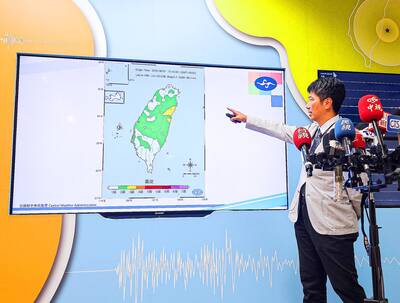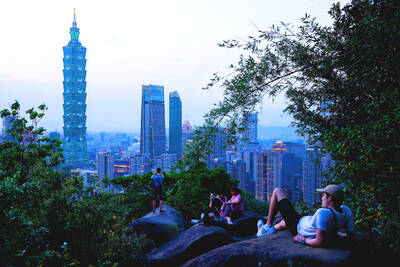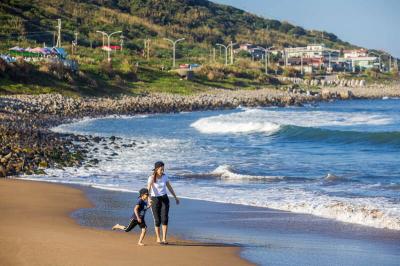Taipei 101 is a building with a lot to boast about. Standing 508m high, it is the world's tallest. And at 700,000 tonnes, it must be among the heaviest.
But the sheer size of the skyscraper has raised unexpected concerns that may have far-reaching implications for the construction of other buildings and man-made megastructures.
Taipei 101 is thought to have triggered two recent earthquakes because of the stress that it exerts on the ground beneath it.
According to geologist Lin Cheng-horng (
If he is right, then it raises concerns about proposals such as Sky City 1000 in Japan, the vertical city that has been proposed to solve Tokyo's housing problems. And it is not just skyscrapers that are a problem. Dams and underground waste deposits may also cause rumblings if they become too large.
Before the construction of Taipei 101, the Taipei basin was a very stable area with no active earthquake faults at the surface. Its earthquake activity involved micro-earthquakes (less than magnitude 2) happening about once a year.
However, once Taipei 101 started to rise from the ground, things changed.
"The number of earthquakes increased to around two micro-earthquakes per year during the construction period [1997 to 2003]. Since the construction finished there have been two larger earthquakes [magnitude 3.8 and 3.2] directly beneath Taipei 101, which were big enough to feel," Lin says in his paper, published in the journal Geophysical Research Letters.
Using the construction information, Lin has calculated how much pressure Taipei 101 exerts on the ground. The weight of steel and concrete came to more than 700,000 tonnes. This is spread over an area of 15,081m2, meaning that it exerts a huge pressure of 4.7 bars on the ground below.
"The construction of Taipei 101 is totally different to many other high-rise buildings because it used hybrid structures made of both concrete and steel, to give it added protection from earthquakes and fire. Therefore it has a huge vertical loading on its foundation," Lin says.
And it is this exceptional downward stress that Lin thinks may have caused the extra earthquakes.
Other experts are more cautious about blaming the skyscraper for the earthquakes.
"A building will change the stress on the ground under the building, but this probably won't reach down to around 10km, the level where the earthquakes occurred," says John Vidale, an earthquake expert at the University of California in Los Angeles.
Zygmunt Lubkowski, an earthquake analyst for the engineering firm Arup, is concerned at the lack of data.
"Earthquakes occur on time-scales of thousands to millions of years. From just 10 years of earthquake data it is hard to tell if the extra earthquakes are just noise in the signal or due to the building," Lubkowski says.

Aftershocks from a magnitude 6.2 earthquake that struck off Yilan County at 3:45pm yesterday could reach a magnitude of 5 to 5.5, the Central Weather Administration (CWA) said. Seismological Center technical officer Chiu Chun-ta (邱俊達) told a news conference that the epicenter of the temblor was more than 100km from Taiwan. Although predicted to measure between magnitude 5 and 5.5, the aftershocks would reach an intensity of 1 on Taiwan’s 7-tier scale, which gauges the actual effect of an earthquake, he said. The earthquake lasted longer in Taipei because the city is in a basin, he said. The quake’s epicenter was about 128.9km east-southeast

GENSLER SURVEY: ‘Economic infrastructure is not enough. A city needs to inspire pride, offer moments of joy and foster a sense of belonging,’ the company said Taipei was named the city with the “highest staying power” in the world by US-based design and architecture firm Gensler. The Taiwanese capital earned the top spot among 65 cities across six continents with 64 percent of Taipei respondents in a survey of 33,000 people saying they wanted to stay in the city. Rounding out the top five were Vietnam’s Ho Chi Minh City (61 percent), Singapore (59 percent), Sydney (58 percent) and Berlin (51 percent). Sixth to 10th place went to Monterrey, Mexico; Munich, Germany; Sao Paulo, Brazil; Vancouver; and Seoul. Cities in the US were ranked separately, with Minneapolis first at

The New Taipei City Government today warned about the often-overlooked dangers of playing in water, and recommended safe swimming destinations to cool off from the summer heat. The following locations in the city as safe and fun for those looking to enjoy the water: Chienshuiwan (淺水灣), Baishawan (白沙灣), Jhongjiao Bay (中角灣), Fulong Beach Resort (福隆海水浴場) and Sansia District’s (三峽) Dabao River (大豹溪), New Taipei City Tourism and Travel Department Director-General Yang Tsung-min (楊宗珉) said. Outdoor bodies of water have variables outside of human control, such as changing currents, differing elevations and environmental hazards, all of which can lead to accidents, Yang said. Sudden

The Japan-Taiwan Exchange Association has cautioned Japanese travelers to be vigilant against pickpockets at several popular tourist spots in Taiwan, including Taipei’s night markets, the Yongkang Street area, Zhongshan MRT Station, and Jiufen (九份) in New Taipei City. The advisory, titled “Recent Development of Concerns,” was posted on the association’s Web site under its safety and emergency report section. It urges travelers to keep backpacks fully zipped and carried in front, with valuables placed at the bottom of the bag. Visitors are advised to be especially mindful of their belongings when taking photos or speaking on the phone, avoid storing wallets and